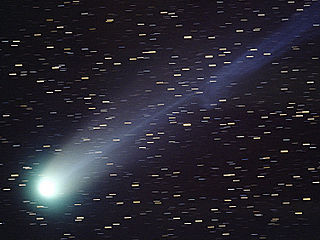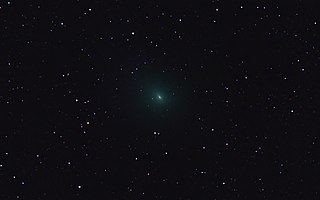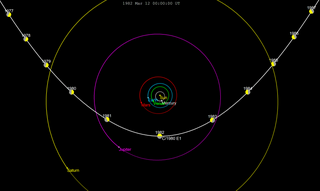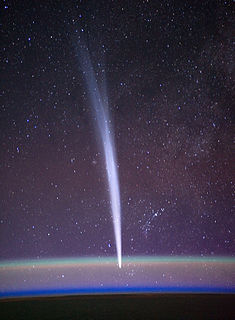Related Research Articles

A comet is an icy, small Solar System body that, when passing close to the Sun, warms and begins to release gases, a process called outgassing. This produces a visible atmosphere or coma, and sometimes also a tail. These phenomena are due to the effects of solar radiation and the solar wind acting upon the nucleus of the comet. Comet nuclei range from a few hundred meters to tens of kilometers across and are composed of loose collections of ice, dust, and small rocky particles. The coma may be up to 15 times Earth's diameter, while the tail may stretch beyond one astronomical unit. If sufficiently bright, a comet may be seen from Earth without the aid of a telescope and may subtend an arc of 30° across the sky. Comets have been observed and recorded since ancient times by many cultures.

Comet Hale–Bopp is a comet that was perhaps the most widely observed of the 20th century and one of the brightest seen for many decades.

Comet Hyakutake is a comet, discovered on 31 January 1996, that passed very close to Earth in March of that year. It was dubbed The Great Comet of 1996; its passage near the Earth was one of the closest cometary approaches of the previous 200 years. Hyakutake appeared very bright in the night sky and was widely seen around the world. The comet temporarily upstaged the much anticipated Comet Hale–Bopp, which was approaching the inner Solar System at the time.

A sungrazing comet is a comet that passes extremely close to the Sun at perihelion – sometimes within a few thousand kilometres of the Sun's surface. Although small sungrazers can completely evaporate during such a close approach to the Sun, larger sungrazers can survive many perihelion passages. However, the strong evaporation and tidal forces they experience often lead to their fragmentation.

Comet Machholz, formally designated C/2004 Q2, is a long-period comet discovered by Donald Machholz on August 27, 2004. It reached naked eye brightness in January 2005. Unusual for such a relatively bright comet, its perihelion was farther from the Sun than the Earth's orbit.

Comet Arend–Roland was discovered on November 8, 1956, by Belgian astronomers Sylvain Arend and Georges Roland on photographic plates. As the eighth comet found in 1956, it was named Arend–Roland 1956h after its discoverers. Because it was the third comet to pass through perihelion during 1957, it was then renamed 1957 III. Finally, it received the standard IAU designation C/1956 R1 (Arend–Roland), with the "C/" indicating that it was a non-periodic comet and the "R1" showing that it was the first comet reported as discovered in the half-month designated by "R". The last is equivalent to the period September 1–15.
The Kreutz sungrazers are a family of sungrazing comets, characterized by orbits taking them extremely close to the Sun at perihelion. They are believed to be fragments of one large comet that broke up several centuries ago and are named for German astronomer Heinrich Kreutz, who first demonstrated that they were related. A Kreutz sungrazers's aphelion is about 170 AU from the Sun; these sungrazers make their way from the distant outer Solar System from a patch in the sky in Canis Major, to the inner Solar System, to their perihelion point near the Sun, and then leave the inner Solar System in their return trip to their aphelion.
Comet C/2006 M4 (SWAN) is a non-periodic comet discovered in late June 2006 by Robert D. Matson of Irvine, California and Michael Mattiazzo of Adelaide, South Australia in publicly available images of the Solar and Heliospheric Observatory (SOHO). These images were captured by the Solar Wind ANisotropies (SWAN) Lyman-alpha all-sky camera on board the SOHO. The comet was officially announced after a ground-based confirmation by Robert McNaught on July 12.

Comet McNaught, also known as the Great Comet of 2007 and given the designation C/2006 P1, is a non-periodic comet discovered on 7 August 2006 by British-Australian astronomer Robert H. McNaught using the Uppsala Southern Schmidt Telescope. It was the brightest comet in over 40 years, and was easily visible to the naked eye for observers in the Southern Hemisphere in January and February 2007.

Comet 96P/Machholz or 96P/Machholz 1 is a short-period sungrazing comet discovered on May 12, 1986, by amateur astronomer Donald Machholz on Loma Prieta peak, in central California using 130 millimetres (5.1 in) binoculars. On June 6, 1986, 96P/Machholz passed 0.40373 AU from the Earth. 96P/Machholz last came to perihelion on October 27, 2017, and will next come to perihelion on January 31, 2023. The comet has an estimated diameter of around 6.4 km (4.0 mi).

45P/Honda–Mrkos–Pajdušáková is a short-period comet discovered by Minoru Honda December 3, 1948. It is named after Minoru Honda, Antonín Mrkos, and Ľudmila Pajdušáková. The object revolves around the Sun on an elliptical orbit with a period of 5.25 years. The nucleus is 1.3 kilometers in diameter. On August 19 and 20, 2011, it became the fifteenth comet detected by ground radar telescope.
D/1770 L1, popularly known as Lexell's Comet after its orbit computer Anders Johan Lexell, was a comet discovered by astronomer Charles Messier in June 1770. It is notable for having passed closer to Earth than any other comet in recorded history, approaching to a distance of only 0.015 astronomical units. The comet has not been seen since 1770 and is considered a lost comet.

An extinct comet is a comet that has expelled most of its volatile ice and has little left to form a tail and coma. In a dormant comet, rather than being depleted, any remaining volatile components have been sealed beneath an inactive surface layer.

C/1980 E1 is a non-periodic comet discovered by Edward L. G. Bowell on 11 February 1980 and which came closest to the Sun (perihelion) in March 1982. It is leaving the Solar System on a hyperbolic trajectory due to a close approach to Jupiter. Since its discovery only 1I/ʻOumuamua and 2I/Borisov have been identified with a faster such trajectory.

Comet Lovejoy, formally designated C/2011 W3 (Lovejoy), is a long-period comet and Kreutz sungrazer. It was discovered in November 2011 by Australian amateur astronomer Terry Lovejoy. The comet's perihelion took it through the Sun's corona on 16 December 2011, after which it emerged intact, though greatly impacted by the event.

Comet ISON, formally known as C/2012 S1, was a sungrazing comet discovered on 21 September 2012 by Vitaly Nevsky and Artyom Novichonok.
Comet C/2012 E2 (SWAN) was a Kreutz group sungrazing comet discovered by Vladimir Bezugly in publicly available images taken by the SWAN instrument on board the SOHO spacecraft. It is recognized for being the first Kreutz sungrazer observed in SWAN imagery.
Comet C/2015 F5 (SWAN-XingMing) was discovered on March 29, 2015 in near real time SWAN images of the SOHO spacecraft, by Szymon Liwo and Worachate Boonplod. It was also independently discovered on April 4, 2015 by Guoyou Sun and Gao Xing at the XingMing observatory near Ürümqi, China. At discovery, the comet had just passed perihelion and was only 0,35 AU from the Sun, shining at about +10 mag. As of May 2015 the comet had faded below mag +13. The comet is periodic with an orbital period of about 61 years.

C/2020 F3 (NEOWISE) or Comet NEOWISE is a long period comet with a near-parabolic orbit discovered on March 27, 2020, by astronomers during the NEOWISE mission of the Wide-field Infrared Survey Explorer (WISE) space telescope. At that time, it was an 18th-magnitude object, located 2 AU away from the Sun and 1.7 AU away from Earth.

C/2020 F8 (SWAN), or Comet SWAN, is an Oort cloud comet that was discovered in images taken by the Solar Wind Anisotropies (SWAN) camera on March 25, 2020, aboard the Solar Heliospheric Observer (SOHO) spacecraft. In the glare of twilight, Comet SWAN is difficult to find with 50mm binoculars even though it is still near the theoretical range of naked eye visibility. The comet has dimmed since May 3. As of perihelion, the comet is very diffuse, does not have a visible nucleus and is not a comet that will be noticed by inexperienced observers. It is likely that the comet disintegrated.
References
- ↑ "Confirmed SOHO comets of 2015".
- ↑ Yoshida, Seiichi. "C/2015 F3 (SWAN)".
- ↑ "Twitter Karl Battams".
- ↑ Arnold, Luc. "C/2015 F3 (SWAN)".
| | This comet-related article is a stub. You can help Wikipedia by expanding it. |

